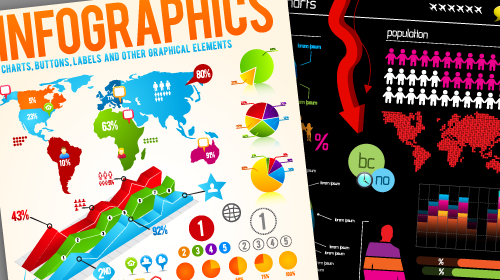Infographics Smackdowns
The increased interest in information graphics has also brought increased debate over their use, abuse and effectiveness. Connie Malamed over at Understanding Graphics even questions the correct usage of the terms "infographics," noting that most of the time, "infoposter" is more appropriate. (I even use the term "data collage" in certain cases.)
There is no question that infographics and data visualizations are becoming powerful communication tools in journalism, online and in business. One of my colleagues credits the creation of an infographic for one of our client's products with getting an important news article placed in a major national paper. The infographic itself was never printed, but it successfully "sold" the story to the newspaper.
NiemanWatchdog.org recently criticized and cautioned the media for misuse of infographics in covering the Bin Laden killing. They rightly point out that just because you're drawing a picture instead of using words, you still can't make stuff up. (Would you make up sales numbers if you used a bar chart instead of prose?) They laid out 6 rules journalists and the media should follow in using infographics.
Chartjunk Dustup
Stephen Few is one of the leading voices in data design and his books and site are must-reads. He is a passionate advocate for simplicity and clarity in charts, and he recently reignited a debate over whether there actually is any merit in the type of chartjunk that Edward Tufte rails against.
Last year a group of researchers published a study arguing that embellished USA Today-like charts and graphs are actually more "sticky" and communicative to a reader than Few's/Tufte's more spartan styles.
Stephen wrote a critical article respectfully taking exception to the methodologies and findings of the researchers.
If you're not Tufte-d out, both Few's article and the original study, are worth a read. Plus, Bruce Gabrielle gives a nice summative overview of the study and its problems at SpeakingPPT.
Few vs. McCandless
Stephen also ruffled a few feathers by criticizing on his blog the work and style of David McCandless. There were a lot of comments back and forth on Stephen's post and even more in a post on Flowing Data, one of the top sites dedicated to information design.
If you're not familiar with McCandless' work, a good introduction is his TED talk.
* * *
Well, for what it's worth, I agree with Stephen Few's work and approach. I love David McCandless's style. I respect Edward Tufte, and I also admire Nigel Holmes, whose work is often held up as representative of needless chartjunk and embellishment. (But yes, Nigel, you do need to work on that website of yours...)
All that said, I disagree with all of them to varying degrees when it comes to certain things. But I'm glad there is so much passion and that the debate is so lively! Information design is a continually and rapidly developing discipline that holds great promise. I'm seeing firsthand major companies desperate to be able to visually communicate their stories elegantly, succinctly and smartly. Hardly a day goes by now in which the word "infographic" is not part of some conversation at work.
And I'm not even going to go into "Big Data," a tidal wave of an issue McKinsey just released a large report about.


